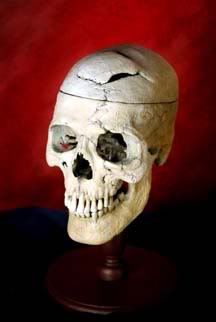Seeing the Brain as Mind: A Slippery Can of Worms
Few would argue today that the brain is not a thought processing organ, and yet the idea of the brain being the physical basis for our feelings and personality—-the root of what we consider "self"—-is still forbidden fruit.
 Too suggest that one's character and drive reside in mere cortical connections, too reduce a feeling as grand and consuming as love to chemicals and synapses, is insulting to us as human beings because it seems to demystify the concepts. Rene Descartes (at right) thought the physical body was connected to the soul via the pineal gland. The "mind" and "body" were two distinct components of a person. In the book Descartes' Error (which will be used extensively throughout this essay), Antonio Damasio suggests that the mind is not "reduced" when it is put in the context of the brain. We only consider it insulting because we do not fully understand the wonder, plasticity, and complexity of the brain. This distinction between mind and brain, in some cases, can even be damaging. Individuals with neurologically driven mental illnesses are still condemned in the public eye instead of given the compassion one might give to an individual with a disorder of any other organ like the heart or kidney. Demasio (1994) wrote of the mind-brain distinction:
Too suggest that one's character and drive reside in mere cortical connections, too reduce a feeling as grand and consuming as love to chemicals and synapses, is insulting to us as human beings because it seems to demystify the concepts. Rene Descartes (at right) thought the physical body was connected to the soul via the pineal gland. The "mind" and "body" were two distinct components of a person. In the book Descartes' Error (which will be used extensively throughout this essay), Antonio Damasio suggests that the mind is not "reduced" when it is put in the context of the brain. We only consider it insulting because we do not fully understand the wonder, plasticity, and complexity of the brain. This distinction between mind and brain, in some cases, can even be damaging. Individuals with neurologically driven mental illnesses are still condemned in the public eye instead of given the compassion one might give to an individual with a disorder of any other organ like the heart or kidney. Demasio (1994) wrote of the mind-brain distinction:"The distinction between disease of the 'brain' and 'mind,' between 'neurological' problems and 'psychological' ones, is an unfortunate cultural inheritance that permeates society and medicine." (pg 40)
The public disapproval of the idea that the mind and brain are so intimately linked perhaps arises from a fear that this indicates a lack of control over ones mind since it is the product of a physical brain. This is not so. The mind—-our thoughts, our feelings, and our personality-—are direct products of brain activity. At the same time though, the brain is a direct product of our mind. Thoughts are what create neural networks in the ever changing, plastic brain. Consider the act of studying. If one wants to learn something, one reads and practices those thoughts until eventually they "stick." These acts are literally changing the landscape of the physical brain. With every thought, synapses are modified and neurons are changed to become more or less receptive to the firings of their neighbors. It is not so scary now to think of the mind and brain as one, when we realize we are still in control.
Character in the Brain
Character is one trait that is often not associated directly with the physical brain, but just as speech, vision, and movement have their places in the brain, so too does character. Imagine an individual who displays no defect in intelligence, memory, or perception, but has lost any interest in work, has become devoid of social sensitivity, and has begun making brash decisions.
 This individual displays symptoms of a psychological disorder of character called the "Phinease Gage Matrix" (named after the first documented case study whose skull is at left). This so called psychological disorder has true neurological roots. When damage is done directly to the ventromedial sector of prefrontal cortex, this remarkable change in character is observed. There exists a myriad of case studies to support this claim, thanks in part to the cruel practice of prefrontal leucotomy, which was a common place cure for severe anxiety in the 1940s. The practice would cure the anxiety, but left patients with an altered personality often likened to "the mind of a child." This analogy is not inaccurate, as the prefrontal cortex is the last to develop in humans and is usually not complete until the child reaches its teens (Gogtay et al., 2004). Emotional defect and decision making defect often go hand in hand with damage to the ventromedial prefrontal cortex. Damasio notes that a "...reduction in emotion may constitute an equally important source of irrational behavior" (Damasio, 1994, p. 53). A certain degree of anxiety, it seems, is necessary to keep character in check.
This individual displays symptoms of a psychological disorder of character called the "Phinease Gage Matrix" (named after the first documented case study whose skull is at left). This so called psychological disorder has true neurological roots. When damage is done directly to the ventromedial sector of prefrontal cortex, this remarkable change in character is observed. There exists a myriad of case studies to support this claim, thanks in part to the cruel practice of prefrontal leucotomy, which was a common place cure for severe anxiety in the 1940s. The practice would cure the anxiety, but left patients with an altered personality often likened to "the mind of a child." This analogy is not inaccurate, as the prefrontal cortex is the last to develop in humans and is usually not complete until the child reaches its teens (Gogtay et al., 2004). Emotional defect and decision making defect often go hand in hand with damage to the ventromedial prefrontal cortex. Damasio notes that a "...reduction in emotion may constitute an equally important source of irrational behavior" (Damasio, 1994, p. 53). A certain degree of anxiety, it seems, is necessary to keep character in check.The Brain as the Organ of Emotion
Today it is becoming more acceptable to consider defects in affect as biologically based in the brain. Modern anti-depressants and anti-anxiety pills are widely used and target certain neurotransmitters. Damasio argues though that this may not necessarily be a move in the right direction. Damasio (1994) wrote of neurochemistry:
"When it comes to explaining behavior and mind, it is not enough to mention neurochemistry. We must know whereabouts the chemistry is, in the system presumed to cause a given behavior." (p. 77)
For example, serotonin (the lack thereof) is the presumed cause of depression in many individuals. This is not necessarily so, as serotonin is active in many circuits in the brain. It is the lack of serotonin in a few local circuits that can affect whole systems in the complex, interconnected realm of the brain. Even then, Damasio suggests that the environment, body, and mind act in an ever circular relationship to create an overall sense of emotion. There is a continuous relay of stimulus from the brain to the body to the environment and back which makes an emotional state possible. The biofeedback from the muscles involved in such emotional acts as clenched fists or smiling stimulates the brain's response and vice versa. An emotional state then becomes the sum of all factors: thoughts, actions, and the environment.
As much as all of these components are seen in an emotional response, the brain seems to be the very root and a base necessity for emotion to occur. Severe emotional defects result with pointed damage to the brain alone. The prefrontal cortex, for one, is an important connecting point between emotion and decision making. Damage to this area, as previously mentioned, results in the absence of anxiety and other emotional states as well as faulty decision making and poor reasoning. The amygdale is another key player in emotion, especially emotion in connection to leaning and memory due to its association with the hippocampal formation (Davis, 1994). The ventral striatum, especially the nucleus accumbens, is the emotional reward center for the brain (Pecina et al., 2006). The insula is what connects the body’s autonomic responses to emotion with the brain, and helps with the bio-feedback involved with the circular emotive process. All of these structures and others are required for a full emotional experience.
Conclusion
The brain and the mind are an inseparable unit. Together, they interact in a constant circular relationship with the body and environment to produce a sense of wholeness and self. Character and emotion both have their roots in neurological structures. Without these structures, severe defects of character or affect are inevitable.
Works cited
Damasio, A. R. (1994). Descartes’ error: Emotion, reason, and the human brain. New York, NW: Penguin Books.
Davis, M. (1994). The role of the amygdale in emotional learning. International Review of Neurobiology, 36, 225-266
Gogtay, N., Giedd, J.N., Lusk, L., Hayashi, K.M., Greenstein, D., Vaituzis, A.C., et al. (2004). Dynamic mapping of human cortical development during childhood through early adulthood. Proceedings of the National Academy of Sciences of the United States of America, 101(21), 8174-8179.
Pecina, S., Smith, K.S., & Berridge, K.C. (2006). Hedonic hot spots in the brain. Neuroscientist, 12(6), 500-511.

